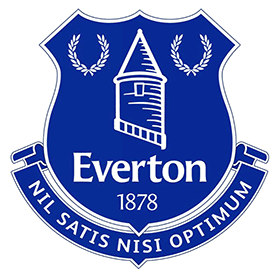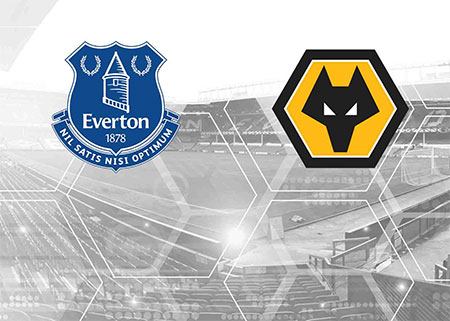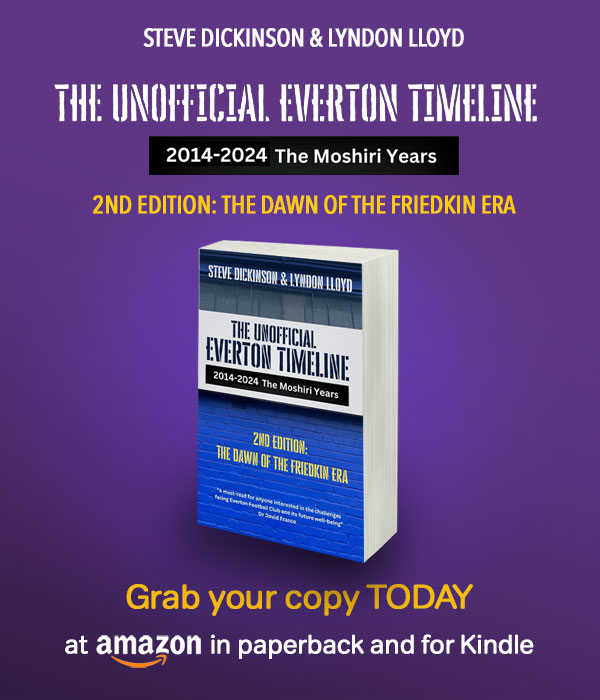Everton's Origins
- The Everton name
- The Everton Crest
- The Everton Motto
- The Toffees
- The Everton Record of Distinction:
- Everton Colours
- School of Science
- Z-Cars Theme
- Everton v Liverpool
THE EVERTON NAME
Everton FC started off as a church team, the team of St Domingo's FC formed in 1878, two years after the church had established a cricket club. The church happened to be in the Liverpool district of Everton, which was then an affluent merchants' suburb. Within a year, the club changed its name to Everton as it was attracting the interest of "folk beyond the church".The November 1879 decision was made at a meeting held in the Queen's Head Hotel, Village Street, which was, coincidentally, situated very close to "Ye Ancient Everton Toffee House". Of course, all this begs the question: Where does the word Everton originally come from?
It is from Anglo-Saxon, a language that not a few Vikings might well have contributed to, and there is a school of thought that the word Everton is derived from the word eofor (reference: A History of Britain — the Saxons and the Normans by Tim Woodwhich) so, with "Ton" being Anglo-Saxon for hill or farm, Everton may have originally been a pig-farm on the hill.
However, maps dating to the early 1700s cite the name Earton (along with "Lerpool") with no "f" or "v" in sight which might suggest a different etemology.
THE EVERTON CREST
 What is that tower?
What is that tower?The Official Crest of Everton Football Club, still one of the best in the English league despite the recent update, has featured a tower erect (in heraldic parlance!), bordered by two wreaths resplendent (indeed!) since Theo Kelly introduced it in 1938. So just what is that tower?
Prince Rupert's Tower, or The Roundhouse, that is identified so strongly with Everton is an old Bridewell or lock-up that is still located on Everton Brow, in Netherfield Road, Everton.
It was named after the Bavarian-born Duke who fought in the Thirty Years’ War and joined Charles I’s army in the English Civil War. His army is said to have stayed in Everton before attacking the Parliamentarians who were holding Liverpool Castle at the time.
The bridewell was built in 1787, and was used to incarcerate wrong-doers and drunks until they could be hauled before the magistrate the following morning.
An early print of Everton Brow by Liverpool artist Herdman in 1800 shows the small round house with a conical roof in the middle of the penfold (cattle enclosure) which had been constructed to incarcerate drunks and deviants for the night.
Also going by the nicknames "Stewbum's Palace" or the "Stone Jug" in its day, there is a display about the lock-up in the Liverpool Museum.
Used primarily these days by council workmen to store their tools, the tower itself had fallen into disrepair but in May 1997, then-chairman Peter Johnson announced a plan to spend £15,000 on renovating what is one of Everton FC's most enduring symbols. The club's Everton One Megastore also incorporated the tower design into its commanding facade.
Prince Rupert's Tower is now also featured on a nice engraving available from the Megastore, standing before the Old Toffee Shoppe.
The depiction of Rupert's Tower has varied in previous versions of the Club crest – the tower had sprung a foundation below the girding fenceline but this was removed in the 2013 and 2014 versions.
THE EVERTON MOTTO
A Short Lecture in Latin
Nil Satis Nisi Optimum Latin, which is variously translated
as:
- Nothing will be sufficient except that which is the best
- Nothing but the best is good enough
- Only the best will do
If the club could always live up to this admirable motto,
we truly would be the best club in the world!
THE TOFFEES
What sort of nickname is
that?
Though "The Blues" has taken hold in recent years, The Toffees (or The
Toffeemen) is the established and traditional nickname for
Everton FC. It originated very early in the history of the club, by
association with not one but two local Toffee Shops that figured
in Everton's early history:
-
Ye Anciente Everton Toffee House was
located within a "mint ball's throw" of the Queen's Head Hotel in Village
Street, where much of Everton's early development as a Football Club occurred.
The Toffee House was the operation of Old Ma Bushell,
who was the original Toffee Lady, and actually invented Everton Toffees.
This confectionery was sold in huge quantities to the hungry hordes as
they journeyed from far and wide to watch Everton play in the new Football League,
firstly in Stanley Park, and Priory Road. Then at Anfield, Everton's
third ground.
- Mother Nobletts Toffee Shop was located near Goodison Park, and figured prominently after the move from Anfield in 1892. Old Mother Nobletts was placed on the horns of a dilemma when that momentous decision was taken to move the great club from Anfield to the new Goodison Park. But, being the mother of innovation, Mrs Nobletts hit upon a great idea as direct competition for the Everton Toffees patented by her arch rival, Old Ma Bushell. Mother Nobletts invented Everton Mints.
Everton Mints were a great success with the crowd. The black-and-white stripes of the new sweets reflected an older strip that Everton had worn some years earlier... Meanwhile, sales of Everton Toffee from Ye Anciente Everton Toffee Shop declined rapidly, mainly due the long distance that now separated Old Ma Bushell's tasty goods from the crowds milling around Goodison Park.
Not to be out-done by the inventive Mrs Nobletts, Old Ma Bushell pulled a masterstroke of marketing acumen. She gained permission from the leaders of the Club to distribute her Everton Toffees to the crowd inside the ground as they waited patiently for the kick-off. Her beautiful young grand-daughter, Jemima Bushell, was persuaded to perform this honourable task. She dressed in her best finery, and donned a broad hat before carrying around her basket laden with individually wrapped Everton Toffees.
And so was born the tradition of the Everton Toffee Lady, a pre-match feature at Goodison Park that has lasted remarkably well down the years. In previous years, one Toffee Lady did the job week-in, week-out: Mary Gorry fulfilled this role in the mid-Fifties. Nowadays, for each home match, a different teenage girl is selected from the ranks of Everton's Supporters Club to perform this time-honoured task.
On the other hand, this yarn may be just so many old half-chewed toffees...
What if the original Everton Nickname was really
The
Taffies, on account some rather strong early connections over
on the west side of Offa's Dyke?
THE EVERTON RECORD OF DISTINCTION
No ContestIf you ever had any cause to doubt that Everton are the best in the land here's a list of achievements and distinctions to set you right!
- Everton have spent more seasons in the top division than any other team having played just 4 seasons outside the top flight
- Only Arsenal and Liverpool have have accumulated more top division points than Everton.
- Only Arsenal have played in more FA Cup semi-finals than Everton.
- Everton have won more FA Cup games than any other team.
- Goodison Park has hosted more top division games than any other ground.
- Goodison Park has hosted more internationals than any other league ground
- Goodison Park hosted the "other" World Cup Semi-Final in 1966 that saw West Germany go through
- Everton's William Ralph "Dixie" Dean holds the record for goals scored in a season (60) and the all-time hat-tricks scored record (37)
- Everton have the unique distinction of being title holders for the duration of both World Wars.
- Everton were one of the 12 founding members of the Football League in 1888 and one of the 20 founder members of the Premier League in 1992.
EVERTON COLOURS
They haven't always been Royal Blue
When Everton changed their name from St. Domingo's, they were only one year
old and played on an open pitch in Stanley Park, probably without any fixed
set of colours.
When Everton were nicknamed the "Black Watch", they played at Anfield and wore all black shirts, having previously played in blue and white stripes.
Everton have played in the following colours:
- White - Playing at Stanley Park
- White/black sash - Playing at Stanley Park
- White/black sash - Playing at Priory Road
- Blue/White stripes - Playing at Anfield
- Black - Playing at Anfield
- Salmon Pink/Dark blue stripes - Playing at Goodison Park
- Ruby with Blue trimmings - Playing at Goodison Park
- Royal Blue - Playing at Goodison Park
- Light Blue - Playing at Goodison Park
- Royal Blue - Playing at Goodison Park
The light blue was for only a year, around 1906. The fans bitterly complained, preferring Royal Blue. In a similar incident, there was such uproar in the 1985-86 season when a sacrilegious white panel was added to the home shirt that the kit was hastily removed the following season, whereupon Everton went on to win the League to make the point that the previous kit was unlucky!
Despite being a shade of red, the ruby shirts and blue trimmings could be an attractive away kit.
In the late Fifties and early Sixties, Everton's away strip was white shirts with a blue sash with either white or black shorts, similar to the Inter Milan away strip. The sash was blue/white/blue.
In the mid to late Sixties, Everton's away strip resembled that of Brazil, with amber shirts and blue shorts.
In the 1980s, Everton's change-strip colours moved to yellow followed by intermittent experiments with white, grey and even a luminous yellow "training kit" through the 1990s.
Incorporating information by John Burns
SCHOOL OF SCIENCE
Hard to live up to...
Through its history, the Everton teams of certain eras have been worthy of
this auspicious title to describe the sublime quality and technical perfection
of the football they played:
- The Thirties teams: 1938-39 in which Everton had the Championship won by Easter.
- Harry Catterick's Championship and Cup-winning teams of the Sixties, culminating with the midfield brilliance of the Holy Trinity, Kendall, Ball, and Harvey.
- Kendall's all-conquering team – World Soccer Team of the Year, 1985.
The origin of the term is not well documented, but some ascribe it to Steve Bloomer of Derby County and England in the late Twenties. It was in 1928, so legend has it, that Bloomer said of Everton: "They always manage to serve up football of the highest scientific order" and "worship at the shrine of craft and science." (Clearly footballers were a good deal more eloquent in those days).
His words stuck, and Goodison Park duly became the School of Science. In real terms this has meant that skill and ability have always been hugely prized, so much so that Everton fans will to this day break into spontaneous and prolonged applause to acknowledge and reward a touch of individual or collective deftness. It is an endearing trait, and makes the club's current miserable plight all the more painful and perplexing. The way in which the term has stuck with Everton over the many years of peaks and troughs is puzzling. The occasions on which the team has deserved this accolade are admittedly rare.
Sadly, the term of such high praise can easily be turned around to inflict the cruelest criticism on Everton's less dazzling performances. Mark Redding penned this in The Guardian, under the headline: School of science shows lack of class after one of Everton's more inept showings (at Coventry in February of 1997):
'There's a feeding frenzy on among you lot at the moment and I've got to be very careful what I say because it may be taken down and used in evidence against me,' the Everton manager [Joe Royle] said.
In that case, and considering the stick he has been taking, it is better to draw a veil over this awful match. Suffice to say that the school of science is no more. The headmaster is about to be carted off to hospital with a persecution complex and the classrooms have been given over to the Bash Street Kids.
This came at the height of a media campaign ruthlessly directed against Royle, the Club and the fans, in retaliation for an earlier decision by Joe Royle to stop talking to the newspapers.
Later, Mark Platt wrote a book entitled School of Science about Everton in the 1960's under the guidance of Harry Catterick. And later still, James Corbett used the phrase to subtitle his unique history of Everton, The School of Science.
If the character of Everton's football under Royle's successors over the following 15 years was necessarily removed from the School of Science heritage, the terms was revived during Roberto Martinez's first season in charge of the club in 2013-14. The Catalan's emphasis on passing football played out from defence was lauded as a return to the Toffees' best footballing traditions and a famous banner and terrace chance proclaimed the day of Martinez's appointment as marking the re-opening of the School of Science.
Z Cars
Why is this the Everton Theme Tune?It was the mid-sixties, the start of a very special era on Merseyside:
-
Everton had won the Championship in 1963
-
The Meresybeat was taking the music world by storm
-
The Beatles had started their fabulous rise to world popularity and fame
-
And BBC tv had an immensely popular new cop-show called Z-Cars
The significance of Z-Cars is that it was set in an undefined area of Merseyside. The series was introduced in 1962 and was an instant hit. It was also a time when regional accents – previously so despised by the BBC establishment – where finally beginning to be heard more regularly on radio and television. Home Counties dominance of the media was being challenged be regional programmes like Z-Cars that were a bit more "cutting-edge" than the usual stuff on telly back then. Z-Cars was streets ahead of its nearest London rival – the cosy and comfortable Dixon of Dock Green... but that's another story.
Z-Cars was based in a fictitious district just outside Liverpool called "Newtown". The setting was one of the new overspill towns that were springing up around British cities after World War II to re-house people after the German blitz and move them out of city-centre Victorian slums.
Most people identified "Newtown" with Kirkby, then in Lancashire, now in Merseyside. The policemen had Lancashire police badges on their hats, not Liverpool ones. Many of the location scenes were actually filmed in Kirkby.
The catchy theme tune chosen by the BBC to herald the Z-Cars series was the music from an old Liverpool folksong called Johnny Todd. And one of the fans, who played PC Sweet on the front desk, was an Evertonian; one day he brought a few of the cast to watch the team. In recognition of that, the team came out on the field to the Z-Cars theme, it has stuck ever since.
It was all about another group of Boys in Blue. Whatever the reason, the theme was introduced midway through the 1963-64 season and became a clarion call for generations of Evertonians.
The original Z-Cars theme was a more sedate fluted version, which Everton first played. A more punchy version was recorded, aimed at the pop charts with some nice saxophone – it was a hit. Everton adopted the punchy version, as did the TV series. This is the version Everton still use today. A revamped version of the tune was also done in 1997 by the group Blueknowz and is available on Tape or CD from the Everton Megastore.
Former Everton Chairman, Peter Johnson, knows to his cost that the Z-Cars theme is an Everton tradition which cannot be trifled with. In the 1994-95 season, a new Everton theme tune was introduced (Fanfare for the Common Man), and the Z-Cars theme was actually dropped for a period. This brazen attempt to jazz things up by riding roughshod over the views of traditional fans was met with derision and condemnation. Within a few short weeks, the experiment was over, and the magical flute of the Z-Cars theme was re-introduced by Joe Royle when he re-joined the club as manager in November 1994.
In the good old days, the teams did not run out together, as they do now. The strains of Z-Cars echoing around the towering Goodison Stands would herald the arrival of Everton in those famous Royal Blue jerseys and white shorts, running out onto a pristine green Goodison turf... a special moment guaranteed to bring out the goose-bumps in every true-blue Evertonian. Subsequently, other teams adopted Z-Cars as their theme-tune – notably Sunderland and Watford, although Peter Reid's Black Cats now run out to Prokoviev's "Peter and the Wolf".
EVERTON v LIVERPOOL
Those Lovable Neighbours
Some startling facts about Everton, and their upstart neighbours across Stanley
Park:
- Without Everton, Liverpool FC might never have existed.
- In 1892, following a disagreement over rent, part of the Everton club split off to form a second club. Everton FC Athletic Grounds Ltd, the team that stayed behind, were forced by the Football League to change their name to Liverpool.
- Liverpool still play on Everton's old ground at Anfield.
- Although the surrounding stands bear no relation to the Anfield that Everton occupied, Liverpool still play on the same pitch. It is still in the same location.
- Everton won their first championship at Anfield in 1891.
- Everton hosted an international at Anfield, such was its reputation at the time.
Not surprisingly, Liverpool fans find these facts quite unpalatable. We have more facts on The Derby.










